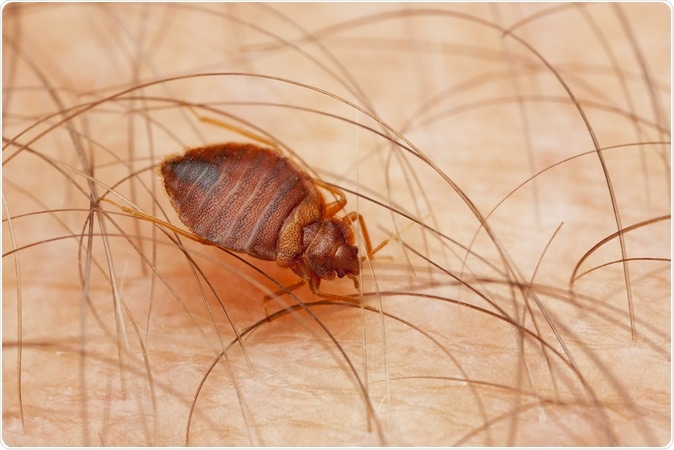According to researchers from University of Sheffield, dirty laundry can attract bed bugs and there is a rise in these parasites that bite and carry a host of diseases. Their study is published in the journal Scientific Reports.
The authors of the study found that bed bugs or Cimex lectularius are known to be attracted to human hosts. When there are no humans around, they tend to hone in on the smell of humans that remains in their worn clothes. William Hentley, an ecologist at the University of Sheffield and first author on the paper said that this is the first time they have noted that human smell could be a magnet for the long distance spread of bed bugs.

The Common Bed Bug, Cimex lectularius, parasite. Image Credit: Pavel Krasensky / Shutterstock
Common bed bugs are visible to the naked eye (being around 5mm long). They have a flat oval shaped body when not fed. After they have sucked on the blood of a human they tend to swell up and become darker in colour. They can survive without feeling for months and usually reside in the beddings and clothing.
The authors explain that bed bugs had started to reduce in their numbers in the 1980s and 90s. However recently they are aggressively on the rise in terms of numbers. In the United Kingdom for example, their numbers have doubled and the numbers are even greater in the United States. Low cost air travel remains one of the culprits of long distance dispersal of these bugs, say experts. They explored how else these bugs may be crossing the seas.
Researchers noted that bags that contained worn clothes were twice as likely to carry bed bugs compared to bags carrying clean clothes.
For this study the team of researchers asked a few volunteers to wear white cotton t-shirts and socks. These were worn for around three hours in the afternoon. Then the soiled clothes were kept in plain cotton tote bags. They also took clean clothes and put them in similar bags. In the lab they took 10 bed bugs that had been fed on blood meal (this means they were not starved). The bed bugs were put in the centre of the room that had the four bags, two each with clean and soiled clothes. The bags were kept in a cross patterns at equal distances. Once the bed bugs were acclimatized to the room, the container lids were removed and they were allowed to roam free for four days.
Bed bugs and other insects that feed on human blood such as mosquitoes and ticks generally are attracted to humans and animals for feeding with the carbon dioxide that they breathe out. In experiments entomologists use blocks of dry ice to attract these insects. The insects are fooled to believe there is a human because dry ice gives out carbon dioxide. For this experiment too, some of the set ups included the bags of soiled and clean clothes and a block of dry ice to make the insect believe there was a sleeping human around. The experiment was repeated multiple times with or without the dry ice.
Results showed that the bed bugs were twice as likely to move towards the soiled clothes as clean ones. They actively went for the dirty laundry and lived inside them especially if there was no dry ice in the room to distract them.
To avoid these bugs, Hentley suggests that keeping the soiled clothes in a ziplock bag may be a good idea. He explained that these bugs cannot crawl up smooth surfaces. So keeping the luggage on the smooth metal luggage racks is another tip to avoid bringing the bed bugs from a trip. Bed bugs he warned, can multiply fast. A female can lay three or four eggs a day, every day till death in about nine months. Further highest strength pesticides are incapable of eradicating these bugs. So, to avoid the bugs and their bites, clean laundry is the only solution for now say experts.